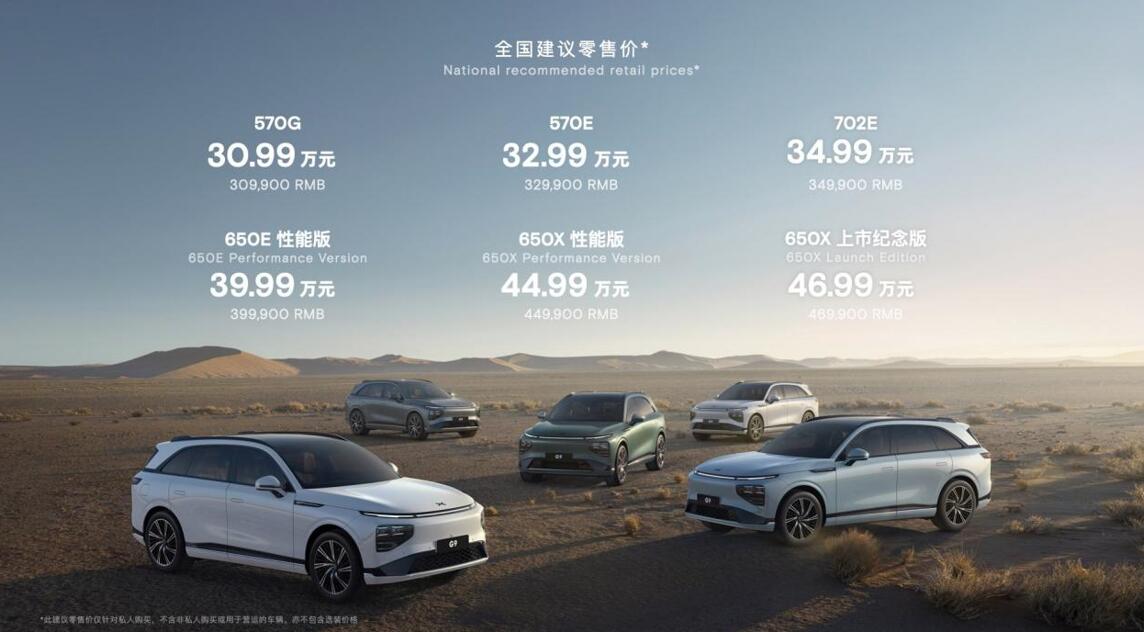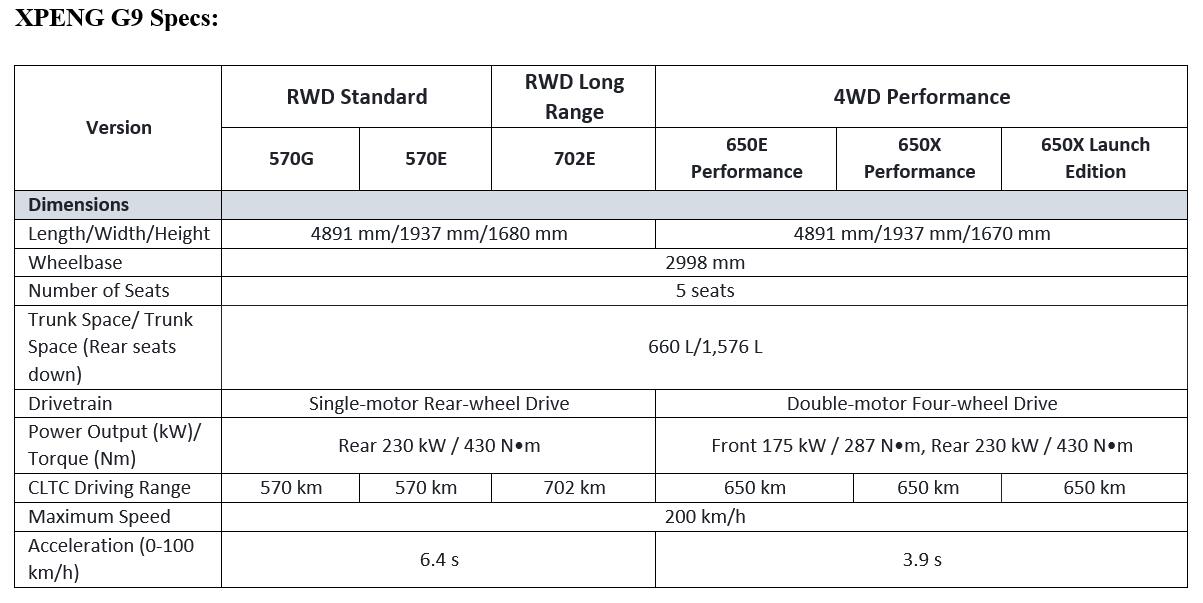Xpeng officially launches G9: Starts at around $44,000, deliveries to start at end of October
Judging by Xpeng's stock performance, investors don't seem to like the pricing of the Xpeng G9, despite the fact that it's another great product for the Chinese market.

Xpeng Motors has officially let its highly anticipated flagship SUV, the G9, go on sale, and while it's another great vehicle, the pricing doesn't seem to be making investors happy.
Xpeng officially launched G9 today in an online event, after having the model unveiled last November.
The Xpeng G9's range includes three options -- 570 km, 650 km and 720 km -- and is currently offered in six versions in total with a price range of RMB 309,900 ($44,000) - RMB 469,900, with deliveries set to begin in late October.

The model is a mid to large-size SUV with a length, width and height of 4,891 mm, 1,937 mm and 1,680 mm respectively, and a wheelbase of 2,998 mm, which Xpeng describes as an "ultra-fast charging all-smart SUV".
The company seems confident in the G9's performance, with chairman and CEO He Xiaopeng saying at the launch that Xpeng believes the G9 will outsell the Audi Q5 and reach sales of over 10,000 units per month next year.
The Audi Q5L sold 12,500 units in China in August, with cumulative sales of 89,685 units in the first eight months, according to PC Auto.
The Xpeng G9 is the first production model from a local automaker based on the 800 V high-voltage SiC platform, with a peak charging power of 430 kW in its 4C version.
When using Xpeng's S4 ultra-fast charging pile, the 4C version can achieve a range of 200 km in 5 minutes of charging, and the fastest charging time from 10 percent to 80 percent is only 15 minutes.
It is worth noting, however, that only the 650X Performance version, which starts at RMB 449,900, supports 4C charging, while other models have a 3C charging multiplier and take as fast as 20 minutes to charge from 10 percent to 80 percent.

The G9 can use third-party charging piles and charges significantly more efficiently than models based on the 400V platform, the company said.
On August 15, Xpeng demonstrated its S4 ultra-fast charging technology and announced the completion of the first S4 pile in Guangzhou, where it is headquartered.
At today's launch, Xpeng announced it will add a total of six new S4 ultra-fast charging stations in Beijing, Shanghai, Guangzhou, Shenzhen and Wuhan.
Xpeng will continue to advance its ultra-fast charging network with plans to build more than 50 S4 ultra-fast charging stations in core cities in China this year and expects to add more than 500 such stations next year.
By 2025, Xpeng hopes to have a cumulative total of more than 2,000 ultra-fast charging stations in operation, the company said.

In terms of performance, the G9's four-wheel-drive version has a maximum motor power of 405 kW (551 hp), maximum torque of 717 Nm and 0-100 km/h acceleration time of 3.9 seconds.
The G9 will be equipped with Xpeng's second-generation assisted driving system called XNGP, which the company says will be the ultimate form of end-to-end, full-scene intelligent assisted driving.
XNGP will enable full coverage of scenarios including highways, urban expressways, internal campus roads, and parking lots for the first time, Xpeng said, adding that it aims to give the model full scenario-assisted driving capability in most cities by 2023 and full point-to-point intelligent navigation-assisted driving capability by 2024.

The six versions of the Xpeng G9 start at RMB 309,900, RMB 329,900, RMB 349,900, RMB 399,900, RMB 449,900, and RMB 469,900, respectively.
The pricing excludes the G9 from China's purchase subsidies for new energy vehicles (NEVs) this year, which will be completely withdrawn next year.
Under current Chinese policy, NEVs priced above RMB 300,000 will not receive subsidies, except for models that support battery swap.
Among the six versions of the G9, only the 702E version is expected to be delivered in October, while all other versions will be delivered in December at the earliest, and the version with the 4C ultra-fast charging battery is expected to be delivered at the end of March next year.
These expected delivery timings make it unnecessary for Xpeng to price the entry model below RMB 300,000 to take advantage of the about RMB 10,000 subsidy.
Pricing for the Xpeng G9 is more complex than for the Model Y, the best-selling premium electric SUV in China.
The Model Y is currently offered in three versions in China, starting at RMB 316,900 for the rear-wheel drive entry version, RMB 394,900 for the dual-motor all-wheel drive Model Y Long Rang, and RMB 417,900 for the dual-motor all-wheel drive Model Y Performance.
The least expensive of the three versions of the Xpeng G9 is equipped with a single motor and has a 0-100 km/h acceleration time of 6.4 seconds, better than the 6.9 seconds of the Model Y entry version.
The other three versions of the Xpeng G9 are all equipped with dual motors and have a 0-100 km/h acceleration time of 3.9 seconds. As a comparison, the Model Y Long Rang is 5.0 seconds and the Model Y Performance is 3.7 seconds.
It is worth noting, however, that for the three lowest-priced versions, consumers will need to spend an additional RMB 50,000 to get premium features including XNGP and 5D music cockpit.


For Wall Street, pricing is the most important factor in measuring the G9's sales prospects.
In a research note sent to investors on August 10, Morgan Stanley analyst Tim Hsiao's team said it expects the Xpeng G9 flagship version to cost close to RMB 350,000 ($52,000) - 400,000, while a version priced around RMB 300,000 should be the key sales driver.
Consumers are expected to compare the G9 to models with similar pricing and wheelbases, such as the Nio ES7, Tesla Model Y, Li Auto's Li ONE and LiL9, and Geely's high-end electric models, Hsiao's team said.
And judging by Xpeng's stock performance, investors don't seem to like the G9's pricing.
As of press time, Xpeng was down more than 9 percent in early trading on Wednesday.


G9 will be key catalyst for XPeng stock in H2, Morgan Stanley says

